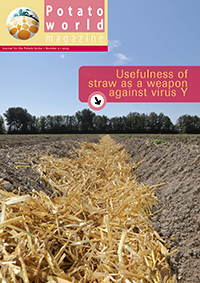Already a subscriber? Activate your premium account

Potatoworld Magazine

Precision agriculture (PA) is a farming management concept based on observing, measuring and responding to inter and intra-field variability in crops. This column focusses on options, limitations and solutions to make potato crop growth and yield monitoring mainstream.
Crop growth and yield monitoring is an essential component of precision farming. It is the basis for sustainable decisions on crop management and reporting to chain parties. Despite many tools developed to monitor and map potato crop growth and yield in the past 20-30 years, with a peak in sensor development in the last 10 years, it is not yet a mature part of potato production on most farms. It has not yet brought the promise it has, resulting in farmers and advisors using manual test sampling at the end of the season quite much to get the yield and quality information they need.
Looking at the various tools, we see different sensor types being deployed. Nearby weight sensors on harvesters assess gross weight (kg per m2) of harvested potatoes at different positions in the field. Such sensors can also be placed on conveyer belts transporting the potatoes into storage, but then spatial variation at field level is lost (yet gross yield per parcel is added value). Remote sensing with optical multispectral sensors on satellites or drones assess aboveground biomass (e.g. NDVI or CI) and provide parameters for crop growth models and yield estimates (tonnes per ha). Such sensors can also be mounted on spray or irrigation booms and then used in same way as the remote sensing systems mentioned. New developments are the (1) use of ground penetrating radar sensors and other types of measurements to assess site specifically number and size of tubers in the soil, and use of (2) cameras on harvesters to assess, number, size and quality of harvested potatoes. Artificial intelligence plays a key role in the development of these measurement systems today.

Besides the sensor based tools, crop growth and yield prediction models regained interest on farm level now that many parcel and crop specific input parameters become more easily available. E.g., remote sensing data on crop emergence date and aboveground biomass are used to better set model parameters. R&D projects at Wageningen (e.g. HIP and DISAC) and elsewhere showed that the performance of complex mechanistic potato models like Tipstar and Wofost improve with use of accurate field and crop specific data (data fusion).
The question is “why is yield mapping not yet an integral component of precision potato production”. An important reason is that the accuracy of each individual tool is not yet good enough. A comprehensive, independent study on the quality of the systems mentioned lacks. Some systems are still experimental. Of those already marketed, error margins of yield predictions are generally more than 10% (nice to know at that moment, but not accurate enough to base management decisions on). The yield mapping systems mentioned indicate relative differences within fields rather good, but the step from relative to absolute values is a large challenge. This requires extra field and crop specific calibration. Models and algorithms have to be made – at least partially – variety specific. This is why farmers and advisors still stick to doing manual test sampling too before harvest. Other limitations in the use of the systems are that the systems are not easy to use and poor interoperability and portability of data.
Despite the difficulties and challenges, I expect that in coming years crop growth monitoring and yield mapping will become mainstream, taking into account the several public and private investments in this R&D done. Hybrid forms of sensor systems and crop growth models will give better information on crop growth during the season. This, combined with weigh and camera systems on harvesters will give site specific information on yield and quality of harvested potatoes. We hope to proof this on Farms of the Future around the world.
Dr. Ir. Corné Kempenaar
Wageningen University & Research, and Aeres University of Applied Sciences
References:
https://subsites.wur.nl/nl/plb/PL-Projecten/DISAC/E-pieper.htm
https://www.hollandinnovativepotato.nl/
https://projecten.netwerkplatteland.nl/nl/project/precisie-technologische-ontwikkeling-pootaardappelen-pop
Events
©2015 - 2024 Potatoworld | Webdesign and realisation COMMPRO